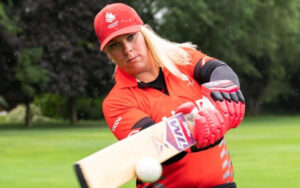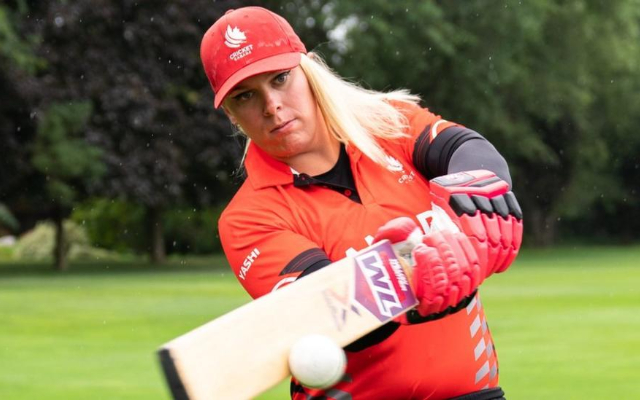
In September, Danielle McGahey, of Australian descent but settled in Canada, became the first transgender cricketer to play an international game against Brazil. On Wednesday, after an extensive nine-month consultation process, the International Cricket Council (ICC) banned male-to-female transgender athletes who have been through male puberty from participating in international women’s cricket. The decision follows in the footsteps of many international sports organisations including World Athletics, World Aquatics, World Rugby Union and the world cycling’s governing body.
Following the ban, McGahey took to social media to announce her retirement. “I promise I will not stop fighting for equality for us [transgender cricketers] in our sport, we reserve the right to play cricket at the highest level, we are not a threat to the integrity or safety of the sport,” wrote the 29-year-old McGahey. “Never stop fighting!”
Geoff Allardice, the ICC chief executive, clarified the decision and released a statement that said: “The changes to the gender eligibility regulations resulted from an extensive consultation process and is founded in science and aligned with the core principles developed during the review. Inclusivity is incredibly important to us as a sport, but our priority was to protect the integrity of the international women’s game and the safety of players.”
ICC Rules Prior to the Ban
McGahey had participated in six T20Is at the ICC T20 Women’s World Cup Qualifying tournament in Los Angeles. She made 118 runs in six innings at an average of 19.66. Her top score was 45 against Brazil.
Danielle was able to become the first trans international cricket player by adhering to ICC’s regulations for male-to-female trans athletes. Prior to the ban, transgender athletes were required to demonstrate a concentration of testosterone in serum less than 10 nanomoles per litre continuously for 12 months or more. She had met all the eligibility criteria.
The Case of Lia Thomas
There has also been a growing debate around Lia Thomas, the first openly transgender swimmer who won the NCAA Division I National Championship in the USA. Thomas lost muscle mass during her transition through hormone replacement therapy and her personal bests started to dip. In the 2018–2019 season she was, when competing in the men’s team, ranked 554th in the 200m freestyle, 65th in the 500m freestyle, and 32nd in the 1650 freestyle. In the 2021–2022 season, those rankings, when competing for the women’s team, were fifth in the 200m freestyle, first in the 500m freestyle, and eighth in the 1650m freestyle. It is also important to remember that although Thomas won the NCAA title, she did not break any records.
Thomas’s competitors have been protesting her presence in the team. Riley Gaines, a successful American swimmer who tied with Thomas in the 2022 NCAA tournament, has been incredibly outspoken about Thomas’s participation in women’s swimming contests. Riley spoke about the team having to share a locker room with someone who hasn’t gone through gender reaffirmation surgery.
Gaines also highlighted that one of the swimmers had been sexually assaulted in the past and had been vocal about being uncomfortable with Thomas’s presence in the locker room. Despite battling anxiety and depression, her discomfort was ignored by the coaches and the swim team was forced to share a locker room with Thomas.
Inclusivity or Protection of Women’s Sport?
The question remains – would the inclusion of trans athletes in women’s sports threaten the integrity of the sport or the safety of women athletes? Women have fought for years to make a spot for themselves in sport, and is their inclusion being threatened again?
Critics who believe trans athletes should not be included in women’s sports look at the debate from a biological perspective. Studies show that going through male puberty gives athletes a massive musculo-skeletal advantage that transition or hormone therapy does not mitigate.
A study by MacDonald-Laurier Institute said this: “For trans women who have successfully suppressed testosterone for 12 months, the extent of muscle/strength loss is only an approximately (and modest) -5% after 12 months.” It added that “testosterone suppression does not remove the athletic advantage acquired under high testosterone conditions at puberty, while the male musculoskeletal advantage is retained.”
While transgender athletes believe that they aren’t a threat to women’s sports, it is important to remember that most athletics bodies have taken decisions based on scientific guidance.
“The performance gap between male and females is more pronounced in sporting activities relying on muscle mass and explosive strength, particularly in the upper body,” said the MacDonald-Laurier Institute study. “Longitudinal studies examining the effects of testosterone suppression on muscle mass and strength in transgender women consistently show very modest changes, where the loss of lean body mass, muscle area and strength typically amounts to approximately 5% after 12 months of treatment.”
In most cases like those of Thomas and McGahey, the two trans athletes had not only been through male puberty, but they had also participated in the men’s category of their respective sports. Going through male puberty and competing in the men’s category for years before transitioning had potentially given them an edge over biological women athletes that could not be mitigated by hormone-replacement therapy.
Although the ICC has imposed a ban on male-to-female trans athletes from participating in women’s cricket, that does not mean the end of what is an impassioned debate. Instead, an open category could be looked at that facilitates and promotes the participation of trans athletes in the sport. Considering the complexity of the issue and the lack of research, sports organisations around the world should strive to create a level playing field and protect the integrity of both women’s sports and trangender athletes.




